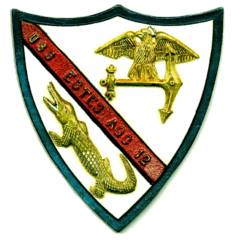
USS ESTES
AGC-12
USS ESTES ASSOCIATION
HOME PAGE
![]()
|
|
USS ESTES
AGC-12 |
|
![]()
![]()
|
One surprise waiting for the sailors at Point Barrow was the sight of
green grass growing only a few feet from the beach overlooking the ice floes. It was
learned that cabbages, potatoes, and other hardy vegetables flourish far north of the
Artic Circle. Roses, lilacs, peonies, lilies, honeysuckle and many varieties of bushes
and berries grow profusely in Northern Alaska.
Before the flagship arrived at Kodiak, many on board had their own preconceived ideas about the "frigid land of ice and snow," called Alaska. Kodiak has a mild climate. And even at Fairbanks, 120 miles south of the Arctic Circle, it is sometimes 100° in the shade. In fact, the Arctic lowlands have an average snowfall less than that of Virginia. "The Land of the Midnight Sun," was viewed by many a sailor who climbed the ladders topside to watch the midnight phenomenoa. While the season of "long days" was the time of year picked by the Task Force for the 1953 visit, the Arctic is never in total darkness because of the refraction of light from below the horizon and the bright moonlight on the snow. An interesting comparison is that you can read print out of doors for approximately the same number of hours during the year in both the Arctic and the Tropics. At Point Barrow, a warm welcome greeted Navy men as they stormed ashore from the landing craft on the gravel beach where the softball game between the Eskimos and the Navy was held Saturday, August 8th. Saliors packing ashore nearly 700 bags of candy had to ward off the tykes and toddlers who grabbed at the apples and oranges long before any organized plan for their distribution could be set up. Some of the younger children were carried by their mothers in papoose-fashion. Others, just able to walk, stumbled along the pebbled beach clutching at their mother's hand. All ages were presented in the turnout that brought hundreds to watch the spirited game. This included a score of attractive girls, of high school age, who gathered around the diamond to root for the home team and, intermittently, cheer the Navy lads to victory. Some of the loudest yelling was heard from the hundred-or-so Native teen-age boys who viewed the game. Shortly after the first boat arrived, Chaplain Bielski and Corporal Schoeller (ComPhibGru-3), marked-off the diamond for the game. Excited youngsters watched as they measured the distance between the bases while another sailor filled the canvas sacks with fine gravel. At this point, the Alaskan children were called together for the treat provided by the ships of Task Force Nine. Second invitations were not necessary, in fact, hardly the first chow call was needed because the small-fry had not wandered far from the food supply. Approximately 600 persons, including both teams, watched the game. Although there were no benches, the crowd lined the diamon, standing throughout the game to cheer for their respective team. Many of the Eskimos wore their Native costumes which included fur-skinned parkas complete with hodds while foul-weather gear was the "uniform-of-the-day" for Bluejackets attending the game. The USS Electra won the Arctic Re-supply Trophy for the year 1953 when the Navy team defeated the Eskimo Cubs 15-8 in the annual Navy-Eskimo game. The Electra was chosen to represent the Navy during the tournament held in Seattle where ships of Task Force Nine were loaded with supplies before heading north. The award was presented by Commander Backland who represented Read Admiral Frederic S. Withington at the game. Commander Backland, an ice pilot with 35 years experience as a trader, ship-owner and skipper is well known at Point Barrow. In making the award, he praised the Electra team for their triumph and congratulated both teams for their good sportsmanship and team spirit shown throughout the game. From the start the spectators supported the game with enthusiastic cheers. In the fifth inning the Natives rivaled a group of Dodger fans when a grand-slam homer climaxed the frame. And even after it appeared certain that the Electra had won the game, the Alaskans maintained their interest and support in the fight. After the game, when the sailors boarded the boats rammed against the soft beach, the Eskimos lined the shore and sang together two hymns as a friendly farewell to the visiting Navy men. "God Be With You Till We Meet Again," was heard as the Natives sang goodbye. |